Search the Blog
Categories
- Books & Reading
- Broadband Buzz
- Census
- Education & Training
- General
- Grants
- Information Resources
- Library Management
- Nebraska Center for the Book
- Nebraska Memories
- Now hiring @ your library
- Preservation
- Pretty Sweet Tech
- Programming
- Public Library Boards of Trustees
- Public Relations
- Talking Book & Braille Service (TBBS)
- Technology
- Uncategorized
- What's Up Doc / Govdocs
- Youth Services
Archives
Subscribe
Category Archives: Information Resources
Those Magnificent Flying Machines
On September 20, 1904, Wilbur Wright flew the first complete circle in history by a manned heavier-than-air powered machine, flying the Wright brothers’ biplane 4,080 feet. It wasn’t a quick circle, taking about a minute and a half. This image from the Library of Congress American Memory Collection of a page from Wilbur’s logbook shows data and a diagram of the flight.
It wasn’t long before Nebraskans were soaring in those flying machines. Dr. Frank A. Brewster  of Beaver City was known as the Flying Doctor. Dr. Brewster embraced new tools to help him with his far-flung practice in western Nebraska and Kansas. He began using a motorcycle in 1903 to make his rounds, and in 1905 got an automobile. In 1919 he bought a biplane and hired World War I pilot Wade Stevens to fly him to his patients. The duo is pictured on the left with the plane. On May 23rd 1919 he flew to Herndon Kansas to perform surgery on an oilfield worker who had suffered a crushed skull in an accident – possibly the first time an airplane was used for commercial or humanitarian purposes. Dr. Brewster continued his flying practice until 1937 and learned to fly himself in 1943, at the age of 71. More images in Nebraska Memories of Dr. Brewster can be viewed here.
of Beaver City was known as the Flying Doctor. Dr. Brewster embraced new tools to help him with his far-flung practice in western Nebraska and Kansas. He began using a motorcycle in 1903 to make his rounds, and in 1905 got an automobile. In 1919 he bought a biplane and hired World War I pilot Wade Stevens to fly him to his patients. The duo is pictured on the left with the plane. On May 23rd 1919 he flew to Herndon Kansas to perform surgery on an oilfield worker who had suffered a crushed skull in an accident – possibly the first time an airplane was used for commercial or humanitarian purposes. Dr. Brewster continued his flying practice until 1937 and learned to fly himself in 1943, at the age of 71. More images in Nebraska Memories of Dr. Brewster can be viewed here.
Air shows in the pioneering days of flight were popular events showcasing flying machines and the skill of the pilots, just as they are today. Aerial performances are dangerous and can be fatal. This summer the pilot was killed at a crash at the Kansas City Air Show in August and there are multiple deaths (11 at this writing) from the crash this month at the Reno Air Race.
We don’t know if the pilot of the plane which crashed on the roof of a barn at an early Nebraska air show survived, but the plane certainly didn’t.  More images of biplanes in Nebraska Memories can be viewed here .
More images of biplanes in Nebraska Memories can be viewed here .
Visit Nebraska Memories to search for or browse through many more historical images digitized from photographs, negatives, postcards, maps, lantern slides, books and other materials.
Nebraska Memories is a cooperative project to digitize Nebraska-related historical and cultural heritage materials and make them available to researchers of all ages via the Internet. Nebraska Memories is brought to you by the Nebraska Library Commission. If your institution is interested in participating in Nebraska Memories, see http://nlc.nebraska.gov/nebraskamemories/participation.aspx for more
information, or contact Beth Goble, Government Information Services Director,
or Devra Dragos, Technology & Access Services Director.
What else happened?
 “The building was completely destroyed by fire on October 31, 1947. The fire started about 11:00 p.m. in the projection room after the second show. About 100 people were in the building. Everyone got out unharmed.” (Opera House, Valley, Neb. from the Valley Public Library collection)
“The building was completely destroyed by fire on October 31, 1947. The fire started about 11:00 p.m. in the projection room after the second show. About 100 people were in the building. Everyone got out unharmed.” (Opera House, Valley, Neb. from the Valley Public Library collection)
When we talk to new and prospective participants to the Nebraska Memories Project, we ask that the images contributed be identified with the basic who, what, where, and when for a general description. But, as we have heard time and again, people especially enjoy the additional stories or information that participating institutions gather about their items. Where does the information come from—the basic as well as extra? Well, participants often use the traditional research tools such as old newspapers, local history books and census records. But many of them also tap into people’s knowledge and memories.
The Valley Public Library, in addition to questioning people individually, organized a coffee and cookies event at the local café. According to Gerri Nordell, invitations were mailed out and transportation arranged to bring in about twenty folks from their homes or the local care facility. Magnifying glasses helped with the small details in photographs, and one person’s memories nudged another’s. After two hours, “they left … still talking about the ‘good old days’.”
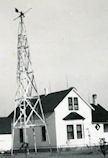 In Sidney, people’s memories had already been tapped for a book on local history. But two volunteers in particular who ran the Cheyenne County Historical Society and Museum added extra details when working with Commission staff. In small communities, these older people often know all the local businesses, families and their homes. And the information, as is found in the record’s Historical Notes field for this image (George and Mabel Jung farm with early wind power from the Cheyenne County Historical Society and Museum collection), can provide insights into the lives and living conditions of people in Nebraska and the Midwest during those earlier times.
In Sidney, people’s memories had already been tapped for a book on local history. But two volunteers in particular who ran the Cheyenne County Historical Society and Museum added extra details when working with Commission staff. In small communities, these older people often know all the local businesses, families and their homes. And the information, as is found in the record’s Historical Notes field for this image (George and Mabel Jung farm with early wind power from the Cheyenne County Historical Society and Museum collection), can provide insights into the lives and living conditions of people in Nebraska and the Midwest during those earlier times.
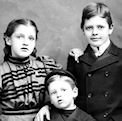 Another volunteer-run project, the Butler County Gallery collection (which consists mostly of studio portraits), used a different approach in tapping people resources. Whenever they heard a family reunion was to be held, they would reach out to promote their collection and ask for information. Feedback included people’s names, birth and death dates, professions and activities, and personal stories. And, of course, corrections! Such was the case with this photograph of Lyle, Fay and Garth Osterhout.
Another volunteer-run project, the Butler County Gallery collection (which consists mostly of studio portraits), used a different approach in tapping people resources. Whenever they heard a family reunion was to be held, they would reach out to promote their collection and ask for information. Feedback included people’s names, birth and death dates, professions and activities, and personal stories. And, of course, corrections! Such was the case with this photograph of Lyle, Fay and Garth Osterhout.
So, if your Nebraska institution has Nebraska-related historical materials that others could enjoy, learn from, or contribute stories to, consider becoming a Nebraska Memories participant. The Nebraska Library Commission hosts the database and will work with your staff on selection of appropriate materials, scanning the items and gathering information to create descriptive records. For more information about participating, see http://nlc.nebraska.gov/nebraskamemories/participation.aspx, or contact Beth Goble, Government Information Services Director, or Devra Dragos, Technology & Access Services Director.
Nebraska Memories is a cooperative project to digitize Nebraska-related historical and cultural heritage materials and make them available to researchers of all ages via the Internet. Visit Nebraska Memories to search for or browse through many more historical images digitized from photographs, negatives, postcards, maps, lantern slides, books and other materials.
Fairs of the past
With the Nebraska State Fair ending earlier this week and many county fairs only distant memories I thought it would be a great time to view some photos of past fairs. As I was looking at the photos of past fairs in Nebraska Memories it’s interesting to see how fairs of the past compare with my current fair memories.
O ne of the items included in Nebraska Memories is a ticket for the fourth annual fair of the Sarpy County Agricultural Society. It was held in Papillion on September 21-24, 1886. As you can see, the ticket is quite fancy with a decorative boarder and a picture of a man and steer printed in red ink. What I find interesting however is the fact that the printed portion of the ticket clearly states it admits the person whose name has been written on the line along with “his wife and children under 18 years of age”. That sure doesn’t look like any fair ticket I’ve ever used.
ne of the items included in Nebraska Memories is a ticket for the fourth annual fair of the Sarpy County Agricultural Society. It was held in Papillion on September 21-24, 1886. As you can see, the ticket is quite fancy with a decorative boarder and a picture of a man and steer printed in red ink. What I find interesting however is the fact that the printed portion of the ticket clearly states it admits the person whose name has been written on the line along with “his wife and children under 18 years of age”. That sure doesn’t look like any fair ticket I’ve ever used.
 Have you ever had your palm read at a fair? This early 1900’s photo shows Madam Seero Temple of Palmistry tent. There is a woman dressed in a costume standing in the entry of the tent who might be Madam Seero herself. Do you think we will ever see a palm reader’s tent at a fair in Nebraska?
Have you ever had your palm read at a fair? This early 1900’s photo shows Madam Seero Temple of Palmistry tent. There is a woman dressed in a costume standing in the entry of the tent who might be Madam Seero herself. Do you think we will ever see a palm reader’s tent at a fair in Nebraska?
 A few things have appeared to stand the test of time. The merry-go-round in this photo from the 1900’s looks a lot like modern-day merry-go-rounds. At a fair this year I saw a number of very nice looking produce exhibits however none of them contained anything as creative as this corn cob log cabin.
A few things have appeared to stand the test of time. The merry-go-round in this photo from the 1900’s looks a lot like modern-day merry-go-rounds. At a fair this year I saw a number of very nice looking produce exhibits however none of them contained anything as creative as this corn cob log cabin.
Take a few minutes and browse the other fair items in Nebraska Memories and think about how fairs of the past compare with your current fair memories.
Visit Nebraska Memories to search for or browse through many more historical images digitized from photographs, negatives, postcards, maps, lantern slides, books and other materials.
Nebraska Memories is a cooperative project to digitize Nebraska-related historical and cultural heritage materials and make them available to researchers of all ages via the Internet. Nebraska Memories is brought to you by the Nebraska Library Commission. If your institution is interested in participating in Nebraska Memories, see http://nlc.nebraska.gov/nebraskamemories/participation.aspx for more information, or contact Beth Goble, Government Information Services Director, or Devra Dragos, Technology & Access Services Director.
Help Preserving Your Collections
Nebraska has many museums and libraries with great historical collections. Getting help to preserve those collections is a big challenge, especially for small organizations. Connecting to Collections Online Community is a new free interactive resource to connect staff at small museums, archives, and libraries with each other and top-flight information about collections care. Visit the site and register (free) to access features such as:
Meeting Room hosting free Webinars with leading conservation professionals
Discussion Forum where online community members can post questions
Calendar of events, online training opportunities, and grant deadlines
Topics Archive of past C2C Online Community discussions and presentations
The Online Community has a Facebook page http://www.facebook.com/C2Ccommunity
The Community is based on the initiative begun by the Institute of Museum and Library Service (IMLS) called Connecting to Collections. The initiative has included grant programs, national forums, workshops, a bookshelf distribution, and webinars.
Book Club Webpage Changes!
Come visit our new book club kit webpage. A couple of new additions have been added that we hope will make it easier to browse and select from our collection of over 250 titles. A new title list includes authors, titles and number of copies. The familiar enhanced lists still includes book covers, links to descriptions, and discussions questions and is now split up into easier to manage lists. Another new feature is an online request form that will make getting all the information we need to make your reservation easy and efficient.
Posted in Books & Reading, Information Resources
Leave a comment
NCompass Live: Birds Do It, Bees Do It: Sexual Health Resources
![]() This Spotlight! on National Library of Medicine Resources, will be presented by Siobhan Champ-Blackwell. This presentation offers reliable resources on sexual health, tips on handling the reference interview, and includes sections on resources for teens, GLBT community members, adults, and older adults.
This Spotlight! on National Library of Medicine Resources, will be presented by Siobhan Champ-Blackwell. This presentation offers reliable resources on sexual health, tips on handling the reference interview, and includes sections on resources for teens, GLBT community members, adults, and older adults.
Download audio (MP3)
Subscribe via RSS
Subscribe via iTunes
View Recording (YouTube)
Presentation Slides (SlideShare)
Links (Delicious)
Posted in Information Resources
Leave a comment
Back to School
It’s that time of year again – time to head back to school! Start your school year off right by exploring images of schools and education in Nebraska Memories.
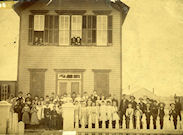 Start by viewing the exteriors of schools through the years. This photograph of a schoolhouse in Sidney was taken in 1887, and it looks very different from this photograph of Bancroft School in Lincoln, taken in the 1950s.
Start by viewing the exteriors of schools through the years. This photograph of a schoolhouse in Sidney was taken in 1887, and it looks very different from this photograph of Bancroft School in Lincoln, taken in the 1950s.
What would school buildings be without the classroom 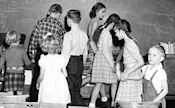 activities inside them? This 1947 classroom at East Olive School in Butler County and this 1924 penmanship class at Bancroft Elementary School in Lincoln are just two examples of Nebraska classrooms.
activities inside them? This 1947 classroom at East Olive School in Butler County and this 1924 penmanship class at Bancroft Elementary School in Lincoln are just two examples of Nebraska classrooms.
 In addition to classes, extracurricular activities are an important part of the school experience. Nebraska schools have had many interesting activities, including a bird lovers’ club at McKinley School in Lincoln and the David City High School men’s quartet.
In addition to classes, extracurricular activities are an important part of the school experience. Nebraska schools have had many interesting activities, including a bird lovers’ club at McKinley School in Lincoln and the David City High School men’s quartet.
Visit Nebraska Memories to search for or browse through many more historical images digitized from photographs, negatives, postcards, maps, lantern slides, books and other materials.
Nebraska Memories is a cooperative project to digitize Nebraska-related historical and cultural heritage materials and make them available to researchers of all ages via the Internet. Nebraska Memories is brought to you by the Nebraska Library Commission. If your institution is interested in participating in Nebraska Memories, see http://nlc.nebraska.gov/nebraskamemories/participation.aspx for more information, or contact Beth Goble, Government Information Services Director, or Devra Dragos, Technology & Access Services Director.
Nebraska Memories Challenge
Earlier this week I had the pleasure of traveling to the Nebraska panhandle. After returning from my trip I took a few minutes to explore the items included in Nebraska Memories from the panhandle region. This was easy to do using the Browse by Location map. Looking at the map you can see that the state is divided into six regions. Clicking on a region will display all of the items in Nebraska Memories that have been identified as being from that specific region of the state.
 I’d like to issue a challenge to everyone reading this blog post. Using the Browse by Location map select a region of Nebraska and view all of the items from that region. As you are viewing the items make note of an item or two that catches your attention. When you are done return to this blog post and leave a comment sharing what region you selected and the title of the item or items that stood out to you.
I’d like to issue a challenge to everyone reading this blog post. Using the Browse by Location map select a region of Nebraska and view all of the items from that region. As you are viewing the items make note of an item or two that catches your attention. When you are done return to this blog post and leave a comment sharing what region you selected and the title of the item or items that stood out to you.
I’ll get things started. I selected the panhandle region. Here are three different photos that caught my attention.
- Welcome sign, Crawford, NE – I liked this photo simply because it made me smile when I read it.
- Millinery Department of the Sidney Mercantile Company – The hats are beautiful and I’m sure the ladies who made them were proud to have their photo taken with them. Looking at the photo however all I can think is how happy I am that those hats are no longer in style because I’d hate to have to wear them.

- McNair Hardware – Look at the great rockers in this photo. I wonder if any of those rockers are still being used today.
If you’re up for the challenge use the Browse by Location map to browse the Nebraska Memories collection and then leave a comment sharing the title(s) of the item(s) that caught your attention. I should warn you I found it hard to limit myself to only three items!
Visit Nebraska Memories to search for or browse through many more historical images digitized from photographs, negatives, postcards, maps, lantern slides, books and other materials.
Nebraska Memories is a cooperative project to digitize Nebraska-related historical and cultural heritage materials and make them available to researchers of all ages via the Internet. Nebraska Memories is brought to you by the Nebraska Library Commission. If your institution is interested in participating in Nebraska Memories, see http://nlc.nebraska.gov/nebraskamemories/participation.aspx for more information, or contact Beth Goble, Government Information Services Director, or Devra Dragos, Technology & Access Services Director.
Posted in General, Information Resources, Nebraska Memories, Technology
4 Comments
Can the Statistical Abstract be Saved?
When I attended the annual Nebraska State Data Center Conference at UNO last week we were given a DVD copy of the 2011 Statistical Abstract of the United States, with the comment that it’s a $150 value and the 2012 edition will be the last one produced.
Robert Samuelson pleads “don’t kill America’s data book” in his column in the August 21 Washington Post. Samuelson notes that the Census Bureau’s 2012 budget would eliminate the Statistical Compendia Branch, which produces the Statistical Abstract, County and City Data Book, and other publications. The cut would eliminate 24 jobs and save $2.9 million dollars. Samuelson suggests that the Census Bureau could seek a private funder for the Abstract like the Gates or McArthur foundations.
I’m not optomistic.
The Public Access Technology Benchmarks Initiative
The Public Access Technology Benchmarks Initiative is a new initiative that has the potential to transform the way that public access technology is delivered and sustained in public libraries. This initiative will create national guidelines that can be used as a tool by libraries— large and small—to assess the quality of computer and internet services and demonstrate their value to local leaders.
The Benchmarks Initiative was launched this spring by a national coalition of organizations that support public libraries, with support from Bill & Melinda Gates Foundation.
How will Benchmarks be used to support the continued growth of library public access technology?
Clearly, the public depends on Nebraska libraries for access to technology. To meet demand and maintain this vital service, technology access at libraries must be continuously improved. For many libraries, this is a struggle.
AND, as local leaders grapple with reduced budgets, they need to understand why investments in public access technology are critical to support citizens and achieve community goals.
Benchmarks are needed:
- To help libraries and communities assess quality
- To provide guidance on how libraries can improve services
- To help demonstrate what support libraries need to maintain quality technology services for communities
Goal of the Benchmark Initiative:
Create and foster the widespread adoption of public access technology benchmarks that the library field and local leaders can use to:
- Assess the quality of public access technology services and set goals for continuous improvement.
- Demonstrate the value of public access technology to people and communities in order to motivate the ongoing investment needed to maintain the quality services.
- Local investment
- Future funding from the Bill and Melinda Gates Foundation will be tied to benchmarks (in some way)
Imagine using the benchmarks to create a dialog with local opinion leaders that helps to frame the issue like this: “If we can do_________with the resources we have know, we could do ___________ with __________.”—helping them to stretch their imagination beyond the library that we have now to the library of the future.
The Benchmarks will be aspirational: they will set a high standard for quality, be motivational and encourage excellence.
Use of the Benchmarks will be voluntary.
The Benchmarks will help all libraries – regardless of size – recognize their achievements and also provide a path for continuous improvement
The Benchmarks will evolve to reflect emerging technologies, behaviors, opportunities and standards of library practice.
Benchmarks will focus on the actual uses of technology:
- Education
- Workforce development
- Access to court, health information, etc.
Use of the Benchmarks will provide clear value for library and local leaders.
Final Thoughts about Benchmarks:
- Voluntary
- Help all libraries communicate their strengths and needs
- Gates funding (and possibly other funding) is likely to be tied to benchmarks in the future.
- Gathering input through March 2012. April 2012: Will implement strategies to encourage widespread adoption of benchmarks.
Now is the time to provide input on how benchmarks should be developed to make sure they work for Nebraska libraries. Click on comment below or contact Mary Jo Ryan (maryjo.ryan@nebraska.gov) at the Nebraska Library Commission to share your ideas and suggestions.
Taken from a presentation at the Nebraska Library Commission’s Technology Planning Summer Camp, August 23, 2011 (#TPSC2011).
Computer Training Resources for Public Access Computers
Lots of great sharing going on at the Technology Planning Summer Camp including the following links to online training resources for library customers using the public access computers (HINT: also great for library staff training):
- www.digitalliteracy.gov/content/educator
- www.gcflearnfree.org
- http://tln.lib.mi.us/blog/techcomm/projects
- www.basicsbee.com/lesson1.html (Internet Basics)
- www.connectcommunity.org/curriculum-center
Also see the newspaper article at:
http://columbustelegram.com/news/local/article_30615d66-40f1-11e0-84df-001cc4c03286.html for an idea that Columbus Public Library put into action. Even if you are not in the Central Community College district, it might be possible to work out this kind of deal with the community college system that serves your area.
Please share resources that you have found/used by clicking on comment below.
#TPSC2011
Posted in Education & Training, General, Information Resources
2 Comments
Dog Days
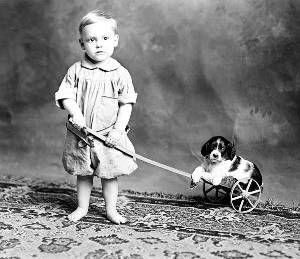 We Nebraskans are used to suffering through blisteringly hot days in late summer, and we sometimes refer to them as the Dog Days. The phrase comes from the Roman calendar, which referred to the period spanning July 24 to August 24 as diēs caniculārēs, associated with the star Sirius. Sirius is called the Dog Star, and is the brightest star in the constellation Canis Major.
We Nebraskans are used to suffering through blisteringly hot days in late summer, and we sometimes refer to them as the Dog Days. The phrase comes from the Roman calendar, which referred to the period spanning July 24 to August 24 as diēs caniculārēs, associated with the star Sirius. Sirius is called the Dog Star, and is the brightest star in the constellation Canis Major.
Another definition from Wikipedia seems ironic considering the anything-but-slow performance of the stock market this summer: In recent years, the phrase “Dog Days” or “Dog Days of Summer” have also found new meanings. The term has frequently been used in reference to the American stock market. Typically, summer is a very slow time for the stock market, and additionally, poorly performing stocks with little future potential are frequently known as “dogs”.
While we may not always associate hot weather with constellations, finance or dogs, the waning days of summer do seem like a good time to celebrate our canine companions. A search in Nebraska Memories brings up a wealth of images of dogs in their various roles. The pampered household pet in the image above must have been the darling of it’s family. 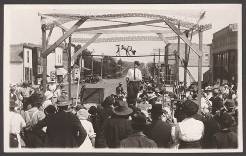
Others were working dogs pulling travois for their native masters or herding cattle for their rancher owners. Still others were entertainers like the dog walking on the tight rope depicted here. I hope it wasn’t too scared doing the high wire act! Or they may simply have been overheated pooches getting into the shade like this one in front of Blondy’s Barber Shop and Pool Hall in Brainard.
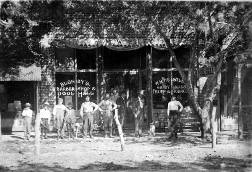 Visit Nebraska Memories to search for or browse through many more historical images digitized from photographs, negatives, postcards, maps, lantern slides, books and other materials.
Visit Nebraska Memories to search for or browse through many more historical images digitized from photographs, negatives, postcards, maps, lantern slides, books and other materials.
Nebraska Memories is a cooperative project to digitize Nebraska-related historical and cultural heritage materials and make them available to researchers of all ages via the Internet. Nebraska Memories is brought to you by the Nebraska Library Commission. If your institution is interested in participating in Nebraska Memories, see
<http://nlc.nebraska.gov/nebraskamemories> for more information, or contact Beth Goble, Government Information Services Director, or Devra Dragos ,Technology & Access Services Director.
New Book Club Kits added!
The following titles have been added to our book club kits. Please contact us if you’d like to reserve any of these for your library. Here is a complete listing of our collection.
Animal Dreams by Barbara Kingsolver, 15 copies
The Five People You Meet in Heaven by Mitch Albom, 10 copies
Fall on Your Knees by Ann-Marie MacDonald, 15 copies
The Handmaid’s Tale by Margaret Atwood, 15 copies
The Hours by Michael Cunningham, 15 copies
In a Sunburned Country by Bill Bryson, 13 copies
In the Time of Butterflies by Julia Alvarez, 15 copies
The Love of a Good Woman by Alice Munro, 15 copies
The Orchid Thief by Susan Orlean, 15 copies
Stern Men by Elizabeth Gilbert, 14 copies
Travels by Michael Crichton, 15 copies
Winona’s Web by Priscilla Cogan, 15 copies
Posted in Books & Reading, Information Resources
Leave a comment
Parks and Recreation
Now that the weather has cooled off a little bit, perhaps you are thinking of getting outside and visiting a local park. If it’s still too hot for you, you can enjoy the images of parks in Nebraska Memories instead. While parks have been an important part of many Nebraska towns, the Nebraska Memories collection is especially rich in images of Omaha’s parks.
 The parks of Omaha have been used for many recreational purposes, including performances. At Hanscom Park, a portable bandstand could be brought in with horses when needed for performance events. Other parks had more permanent structures, such as this pavilion in Riverview Park.
The parks of Omaha have been used for many recreational purposes, including performances. At Hanscom Park, a portable bandstand could be brought in with horses when needed for performance events. Other parks had more permanent structures, such as this pavilion in Riverview Park.

Parks also provide more informal recreational opportunities for children and adults alike. These boys are enjoying a merry-go-round in a local park, and Peony Park provides the backdrop for a game of horseshoes for this group of men.
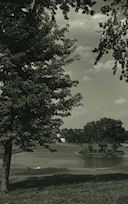 In addition to recreation, parks often serve as nature retreats in the middle of an urban landscape. The long winding drive in Miller Park and the lagoon in Fontenelle Park are just a couple examples of the beauty of nature in the middle of Omaha.
In addition to recreation, parks often serve as nature retreats in the middle of an urban landscape. The long winding drive in Miller Park and the lagoon in Fontenelle Park are just a couple examples of the beauty of nature in the middle of Omaha.
Visit Nebraska Memories to search for or browse through many more historical images digitized from photographs, negatives, postcards, maps, lantern slides, books and other materials.
Nebraska Memories is a cooperative project to digitize Nebraska-related historical and cultural heritage materials and make them available to researchers of all ages via the Internet. Nebraska Memories is brought to you by the Nebraska Library Commission. If your institution is interested in participating in Nebraska Memories, see http://nlc.nebraska.gov/nebraskamemories/participation.aspx for more information, or contact Beth Goble, Government Information Services Director, or Devra Dragos, Technology & Access Services Director.
On the Road Again
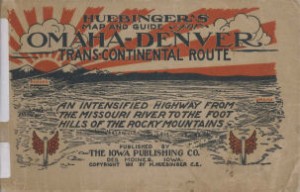 Planning a road trip this summer? Taking along a GPS device? Check out this old-fashioned positioning system— Huebinger’s Map and Guide for Omaha-Denver Trans-continental Route : with Supplement Showing Overland Trail Connecting Omaha-Denver Trans-continental Route at Lincoln with the Waubonsie Trail at Nebraska City (1911) from the Hastings Public Library Collection in Nebraska Memories.
Planning a road trip this summer? Taking along a GPS device? Check out this old-fashioned positioning system— Huebinger’s Map and Guide for Omaha-Denver Trans-continental Route : with Supplement Showing Overland Trail Connecting Omaha-Denver Trans-continental Route at Lincoln with the Waubonsie Trail at Nebraska City (1911) from the Hastings Public Library Collection in Nebraska Memories.
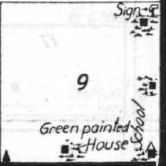 If you are driving east and coming up on Harvard, Nebraska, (page 136) be on the lookout for the green-painted house on the left and then a school where you would turn north. Then, after you pass a pond on the left and a batten-board barn on the right, be ready for a right-turn to head east again. Of course, it helps if you have a navigator along to read off the landmarks.
If you are driving east and coming up on Harvard, Nebraska, (page 136) be on the lookout for the green-painted house on the left and then a school where you would turn north. Then, after you pass a pond on the left and a batten-board barn on the right, be ready for a right-turn to head east again. Of course, it helps if you have a navigator along to read off the landmarks.
Once you’ve made it to Harvard (480.4 miles from Denver and only another 151.9 to Omaha) , do you need a hotel for the night? Try Hotel Harvard—only two dollars on the American plan. Or perhaps you need a garage to top off the gas tank? Two choice are listed. Would you like more information about Harvard and its residents? Check out page 22.
Another book of maps in this collection, Official Road Book of the Nebraska State Automobile Association (1913), includes a digest of states’ auto laws, telling motorists that in Nebraska, they must register with the Secretary of State in Lincoln for a fee of $2 per year and supply their own tags. And keep a light foot on the gas pedal because the speed limits are “10 miles an hour in business section; 15 miles in residence district; 20 miles elsewhere.”
Now, as you pull out of Harvard and head on down the road toward Omaha, keep an eye out for the danger sign ahead by the red barn …
Visit Nebraska Memories to search for or browse through many more historical images digitized from maps, photographs, negatives, postcards, lantern slides, books and other materials.
Nebraska Memories is a cooperative project to digitize Nebraska-related historical and cultural heritage materials and make them available to researchers of all ages via the Internet. Nebraska Memories is brought to you by the Nebraska Library Commission. If your institution is interested in participating in Nebraska Memories, see http://nlc.nebraska.gov/nebraskamemories/participation.aspx for more information, or contact Beth Goble, Government Information Services Director, or Devra Dragos, Technology & Access Services Director.
The Help by Kathryn Stockett
If your book group has been waiting to read The Help by Kathryn Stockett and you’ve been unable to find multiple copies, please contact us to reserve our kit which includes 5 copies. The movie based upon this book arrives in theaters August 10th. Here are some southern recipes as provided by the Ladies in Waiting Book Club to prepare when your club gathers to discuss this title. For other selections in our book club collection, click here.
Posted in Books & Reading, Information Resources
1 Comment
Thoughts of Snow
As the temperature and heat index are reaching the 100+ degree mark for many of us this week I thought it would be the perfect time to think about snow, lots of cold snow. Depending on your viewpoint the thought of snow may make you appreciate the recent hot temperatures or it could give you something cold to dream about.
If you are a snow lover like myself let’s think about how cool life will be in four or five months and the snow is flying. Hopefully the weather will be perfect like it was in the early 1900’s for a little girl and her dog to go skiing and for the Boston sisters to enjoy a sled ride. If you’re a bit adventures you may even enjoy some football like the 1909 Nebraska State Normal School at Kearney football team. Anyone interested in a snowball fight?
 For those of you who do not share my love for snow take a look at these photos of the 1927 and 1949 blizzards that hit Crawford or the large snow fall at Fort Niobrara in the late 1880’s. Think about how cold it must have been when these photos were taken. Does looking at these photos and thinking about past snow falls make the hot temperatures of this week a bit more bearable? Enjoy the heat while you can because before you know it you too may be shoveling snow.
For those of you who do not share my love for snow take a look at these photos of the 1927 and 1949 blizzards that hit Crawford or the large snow fall at Fort Niobrara in the late 1880’s. Think about how cold it must have been when these photos were taken. Does looking at these photos and thinking about past snow falls make the hot temperatures of this week a bit more bearable? Enjoy the heat while you can because before you know it you too may be shoveling snow.
Visit Nebraska Memories to search for or browse through many more historical images digitized from photographs, negatives, postcards, maps, lantern slides, books and other materials.
Nebraska Memories is a cooperative project to digitize Nebraska-related historical and cultural heritage materials and make them available to researchers of all ages via the Internet. Nebraska Memories is brought to you by the Nebraska Library Commission. If your institution is interested in participating in Nebraska Memories, see http://nlc.nebraska.gov/nebraskamemories/participation.aspx for more information, or contact Beth Goble, Government Information Services Director, or Devra Dragos, Technology & Access Services Director.
New Book Club Kits
The following book club kits have been added to our collection. Many authors have a Nebraska affiliation and the city or area is mentioned where available. Please contact the reference desk to borrow these titles for your book group.
(Tilden) The Great Secret by L. Ron Hubbard 10 copies / 1 audio cd
(Tilden) Spy Killer by L. Ron Hubbard 10 copies / 1 audio cd
(Omaha) Murder’s A Cinch by Patricia A. Bremmer, 3 copies
(Omaha) Victim Wanted: Must Have References by Patricia A. Bremmer, 3 copies
(Rural Nebraska) Mercy Sky by Dawn Dyson, 3 copies
(Lincoln) Breathing in the Fullness of Time by William Kloefkorn, 2 copies
(Perkins County) Homefield: Sonata in Rural Voice by Robert Richter, 3 copies
(Omaha) Interior Places by Lisa Knopp, 4 copies
Cryptid: Lost Legacy of Lewis and Clark by Eric Penz, 3 copies
(Omaha) Sweet Eyes by Jonis Agee, 2 copies
(Lincoln) Date You Can’t Refuse by Harley Jane Kozak, 2 copies
Tales of the Fort Whiskey Creek Trading Post by Robert R. Dahlgren, 3 copies
(Columbus) Bandit’s Lady by Irene O’Brien, 3 copies
(Maxwell) Gravestone Marker by Mary Vesta Nickerson, 4 copies
Rodzina by Karen Cushman, 3 copies
Posted in Books & Reading, Information Resources
Leave a comment
Public Access Computer Users: Who Are They?
The Institute of Museum & Library Services has released an interesting study analyzing who is making use of public access computers in libraries and for what purposes they use them. You can find a copy of this information brief online at http://www.imls.gov/pdf/Brief2011_04.pdf
The title of this report is, Who’s in the Queue? A Demographic Analysis of Public Access Computer Users and Uses in U.S. Public Libraries, by Carlos Manjarrez & Kyle Shoembs. Those of us associated with public libraries know that despite rising levels of
home computer ownership and internet access, demand for public access computers in libraries remains high. This paper examines the demographic characteristics of those responsible for this demand compared to the general population. The authors
also demonstrate how the stage and condition of life correlate to the purpose for which people use public access computers.
Things Are Going Swimmingly
Are you tired of the hot July weather? Take a moment to explore these refreshing images of swimmers in Nebraska Memories.
 These women are enjoying the water at Linoma Beach, which was founded in 1924 as a “pleasure resort” halfway between Lincoln and
These women are enjoying the water at Linoma Beach, which was founded in 1924 as a “pleasure resort” halfway between Lincoln and 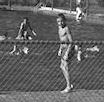 Omaha.
Omaha.
This boy is among the swimmers relaxing at the David City Municipal Pool in a 1948 photograph.
This  swimming hole at an unknown Nebraska location shows another way in which people have taken to the water for recreation.
swimming hole at an unknown Nebraska location shows another way in which people have taken to the water for recreation.
Visit Nebraska Memories to search for or browse through many more historical images digitized from photographs, negatives, postcards, maps, lantern slides, books and other materials.
Nebraska Memories is a cooperative project to digitize Nebraska-related historical and cultural heritage materials and make them available to researchers of all ages via the Internet. Nebraska Memories is brought to you by the Nebraska Library Commission. If your institution is interested in participating in Nebraska Memories, see http://nlc.nebraska.gov/nebraskamemories/participation.aspx for more information, or contact Beth Goble, Government Information Services Director, or Devra Dragos, Technology & Access Services Director.

